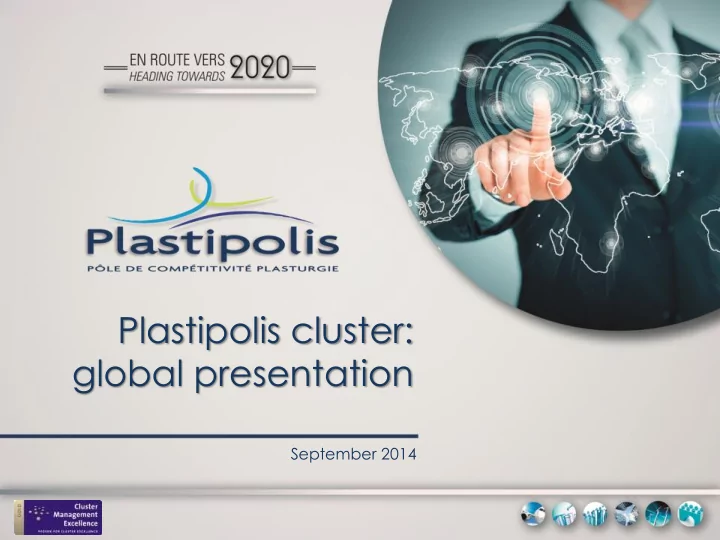

Plastipolis cluster: global presentation September 2014
Plastipolis: Innovation cluster stakeholders Industry and businesses Technical and Education research centers and centers universities Public and Supporting financing network bodies (experts, partners…)
Plastipolis: Cluster figures Established in 2005 More than 340 members with: • 230 firms 90% SMEs Consolidated turnover: 5 500 M € Nb employees : 30 000 • 70 R&D and education centers • 40 institutions • 4 000 contacts (industry & academic) • 125 running projects for 400 M € • More than 170 submitted projects • 270 different companies partners of projects (including 180 SMEs) • 8 new training and education programs • 15 European projects Plastipolis members Status 2013
Plastipolis: Industrial members (1) Primary and secondary activities of companies Axis 1: material technologies Axis 3: 20% Integration of technologies 26% Axis 2: Processes & tooling 54%
Plastipolis: Industrial members (2) Primary and secondary markets of companies Consumer goods.; 11% transportation; 34% Energy; 14% Building & Construction; 11% Health/ medical; Packaging; 16% 14%
Plastipolis: Organization figures Produits d'exploitation Staff: 8 permanent people In 4 offices 1 750 000 € 1 500 000 € Besançon 1 250 000 € 1 000 000 € 750 000 € Bellignat Main office 500 000 € 250 000 € Lyon - € CR CR CR CR CR CR CR Grenoble 2007 2008 2009 2010 2011 2012 2013 autres recettes / contracts subventions de gouvernance / public subsidies Cotisations / memberships
Axis#1: Cluster development tools Meetings, workshops, events Information sharing platform Open innovation system
Axis#1: Cluster development tools
2014 main events
Axis #2: Overall innovation process Plastipolis members Intercluster partnerships Workshops or Support in the building of the working innovation groups project Technology / market Evaluation by an expert Technical committee Firms centers or labs Submission to the public financing authorities Strategic analysis Execution of project and Technology watch implementation of results Business intelligence
Axis #2: Areas of innovation Technologies and markets • 6 final markets • 16 key applications • 4 technology domains Competences • Technical skills • Attractivity of talented people • Management skills • Transversality International development • Technology partnerships • Export • Attractivity for investors Investisment and industrialization • Financing of innovative companies
Market challenges and key applications Transportation Medical & health – Weight reduction – Bio resorbable – Structures for electric implants propulsion systems – Biocompatible – Flame retardant – coatings Materials for batteries – – Drug delivery Bio based materials – systems Recycling – – Labs on chips New propulsion systems – Thermoplastic composites Construction Packaging – Tightness – Bio based materials – Corrosion – High barrier resistance property packaging – Composites – Food contact – recycling Energy Consumer goods – Photovoltaic – Storage – labeling systems – Traceability – recycling – Printed electronics
Technology strategic domains Advanced materials Performant and innovative processes Smart plastics products Controlled reflection Controlled reflection interiors interiors Reconfigurable icons Reconfigurable icons and and transparent diplays transparent diplays Sustainability and eco-design
Strategic domains in the 4 innovation areas Development of Technologies International Competences innovative and markets development companies To match To develop To trigger technology technology and cooperations Advanced materials evolutions and business between competences cooperations into 8 entrepreneurs and needs selected countries investors To support the To attract High added value To attract talented growth of international processes people innovative investors companies To train companies on key Smart plastics competences to products support their development To support Sustainability and integration of co-design transversal competences
European cooperation and interclustering Coordination actions Collaborative projects (FP7 cooperation) Inter-cluster cooperation (FP7 cooperation) (FP7 capacity – Region of knowledge / Interreg 4C) Technology transfer project (FP6 / FP7 ERANET) CLUSTER Strategic vision Innovation for SME (FP6 & FP7 ETP & NoE) (INNET, Tactics- DG Entrerprise)
Examples of European Projects Advanced materials NANOCOM COLAE CORNET Biopolymer • • • Nanomaterials Organic electronics Bio-based materials • • • FP7 FP7 ERANET High added value processes IMPRESS 3D-Hipmas MINAM 2.0 • Surface micro- • MIDs • Micro-manufacturing structuring • FP7 • FP7 • FP7 Cluster cooperations ALPLASTICS WIINTECH • • Regional interclustering International cooperations • • Alpine Sspace DG Entreprise
Example of project: Micro-manufacturing 9 Project partners: KIT, CEA, FhG-IPA, TNO, Uni Nottingham, Profactor Foster and accelerate „horizontal“ and „ vertical “ information CU / 4M Assoc., exchange in the Field of Macro Micro Nano mst bw, Plastipolis Manufacturing Re-orientiation for the MINAM community, Project duration relaunch of activities 12/2010-11/2012
Example of project: Organic electronics COLAE is a pan-European initiative to promote the commercial exploitation of organic and large area electronics (OLAE).
International cooperations Université d’Akron (Ohio - USA) - 2011 Foire d’Hanovre (2010, 2011, 2012) Green Tech Expo (Tokyo-Japon) - 2012 ICC conference (Mumbai - Inde) - 2013
Key international partnerships FEPAC Nagano Techno Foundation Polymer Ohio Tokai Nanotechnology Cluster Mississippi Polymer OBIC Yamaguchi Green Institute Materials Cluster PlastIndia foundation APL Pernambuco Suape APL Porto Priority countries Alegre Opportunity countries Key partners
Recommend
More recommend